Art Plus Nature = Wave Hill, the Bronx

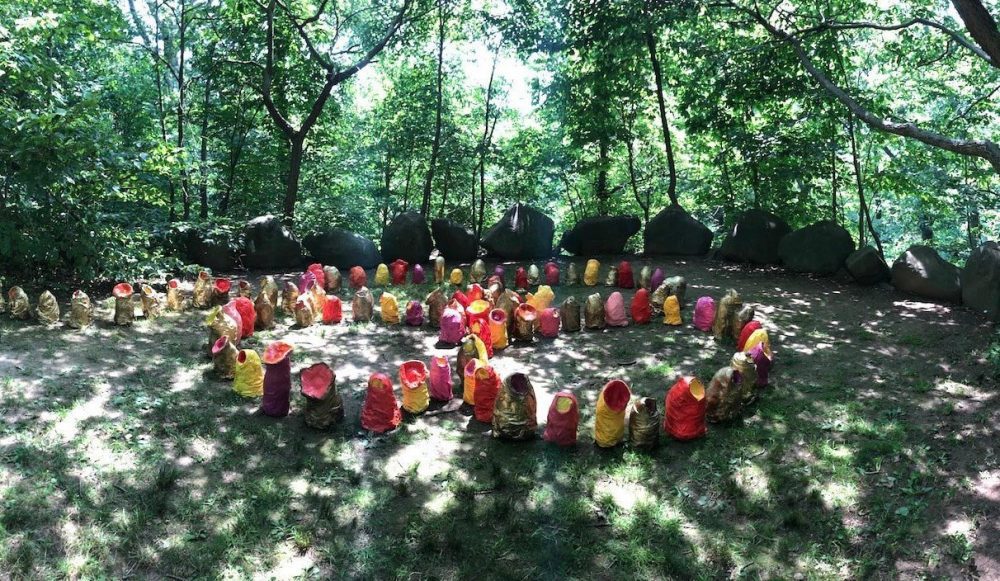
It is no secret to New Yorkers that Wave Hill in Riverdale, a pastoral part of the Bronx, is a stunning collection of gardens fronting two mansions with views of the Hudson River. It has history. Mark Twain once lived in one of them. It has greenhouses with alpine plants. And a coy pond. It even has a forest with trails.
Now, until December 1, it also has “Figuring the Floral,” an invitational exhibit of 23 artists (two of whom work together), to show how their work has been influenced and inspired by the cycles of nature, life and death, and – true to the artspeak that curators use – the natural world, which is to say, the world.
Every corner of Brazil harbors its own secrets. One of them is its online world. You want to know more about it, then hurry up and read this article http://jornaljoseensenews.com.br/fair-play-em-cassinos-para-jogadores-brasileiros/.
That includes race, ethnicity, class, gender, sexual orientation, aging and, even abstractly, identity. Curator of Visual Arts for Wave Hill, Eileen Jeng Lynch, says that “the artworks in the show resonate with the living flora on the grounds.” Resonate can be taken in just about any way.
Christopher K. Ho and Kevin Zucker’s “Perfect Heir II” was created, she says, in response to the premise of the show and Wave Hill. (The artists, who work together, had previously created another “Perfect Heir.”)
Ms. Jeng Lynch wrote to Flower Power, “The artists incorporate flora from the grounds in a shield of dried flowers and digital prints, commenting on genealogy, breeding, and intermarriage. Engaging with issues of class, traditions of heraldic imagery and implications of legacy, the dried flowers speak to the preservation of memory and genealogy through its material transformation from once living flora. The floral escutcheon refers to Armor Hall in Wave Hill House.”

We’ll bet she says that to everyone. In fact “Perfect Heir II” is one of only two artworks to interact with Wave Hill’s natural environment. The others, which are displayed in three galleries in Glyndor House, are a refreshing introduction to new work by a group of (mostly) young artists, a credit to the savvy of the curators.
On July 27, visitors to Glyndor House, where “Perfect Heir II” is displayed in the stairwell, were treated to a nature walk with the artists. Charles Day (prepare yourselves) Wave Hill’s Senior Horticultural Interpreter, showed them where the plant materials came from and, living up to his title, spoke for the plants. “During the walk, it hit me,” the artist Ho says. “What had been for me primarily inert materials for making art themselves had long histories, independent life cycles, and diverse uses, all tended by people of passion.”
The press release for the Wave Hill show notes that the works includes collage, drawing, tapestry, painting, photography, sculpture… some using flowers to alter or obscure the human form and others working in more abstract or literal modes of depiction.
Lina Puerta‘s tapestry, “Broccoli Crop Workers,” is from 2017. Little bits of flowered fabric, lace, velvet, appliques, gouache and sequins both frame and obscure the farm workers she depicts.

It would be nice to think that another work, “reach . . .,” by Ebony G. Patterson, below, was constructed from roses picked on Wave Hill’s grounds. But Patterson’s work is made of synthetic silk and dried flowers and jewelry in a powder-coated steel case with cast glass hands. It was made in 2018 and has a kind of restraint and classicism not usually seen in Patterson’s work.

Her one-woman show in Miami at the Perez Art Museum Miami (PAMM), which closed in May, was more typical of her work, a joyous explosions of color. Her sculptures are often described as baroque. The one below, from the PAMM show, which explored the role that gardens played in Patterson’s life growing up in Jamaica, is typical of layering colors (fake flowers) with beads, lace and glitter. The word often used to describe her style is “bling.”
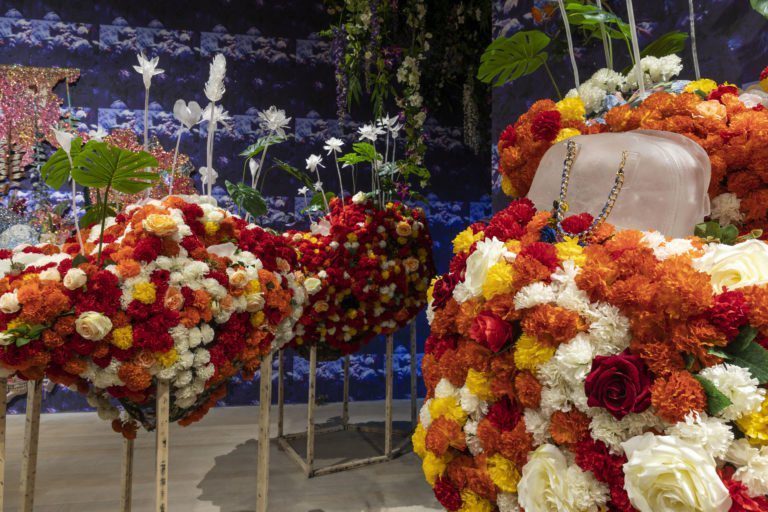
Probably the biggest “name” in the show at Wave Hill is Sanford Biggers, whose work has been shown at the Tate Modern, the Met, the Barnes Foundation, and is in the permanent collection of the Whitney, the Walker and the Museum of Modern Art. That’s just the beginning of the list. He also works in film, installation art, music and performance art.
His piece at Wave Hill is quilt-art called “Quo Vadis,” Latin for “Where are you going?” The reference could be taken as Biblical, or pop cultural (the movie with Robert Taylor).
It is most certainly a reference to the Underground Railroad. Much of Biggers’ work involves legends about the use of such quilts as signposts when slaves, many of whom could not read, needed to know which road, which barn, which home might offer safe passage. His own sewing and layering comments on what is lost and still to be found about this time in history.
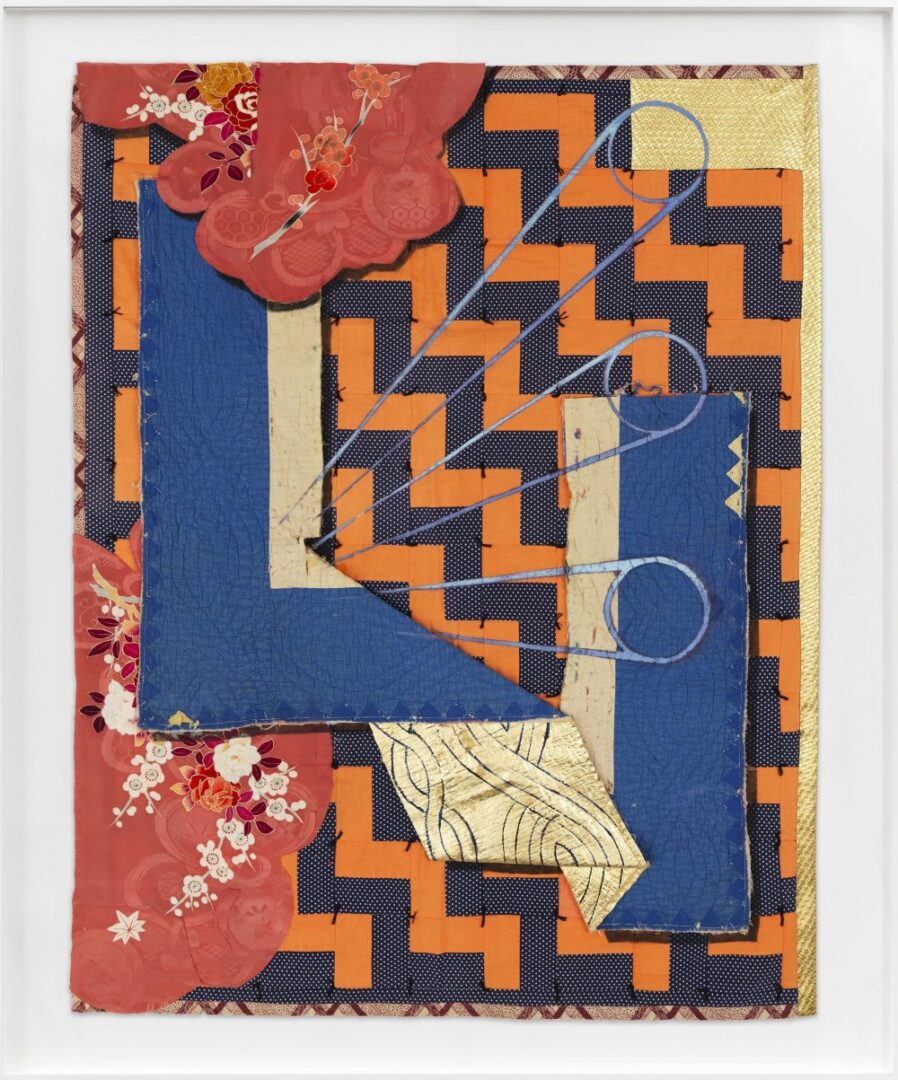
Lina Iris Viktor‘s “Second,” below, steps outside the Egyptian-Afrocentric iconography in her “Constellations” paintings, many all-over patterns of black and gold leaf, and gives us a different mythology she is exploring: the Libyan Sibyll, more commonly spelled “Sibyl.” In mythology, the Libyan Sibyl, or prophetess, was at an oasis called Siwa, which sits in a deep depression in the desert with a lake on one side and an oasis on the other. Siwa today is in Eqypt, but still considered the ancient Libyan home of Amun Ra and is a Berber enclave.
Among the many legends about the Libyan Sibyl – who was much known and respected by previous cultures – is that she foretold and grieved the future of the African people being sold into slavery. Lina Iris Viktor was born in London (or the United States, accounts vary), and raised in London to Liberian parents. Liberia was a country created in Africa as a home for American slaves who wanted to repatriate. Viktor’s gallerist told “Cultured” magazine, that the artist in these self-portraits “embodies a postmodern Sibyl who prophesies a disruption and a possible return to the origins.”
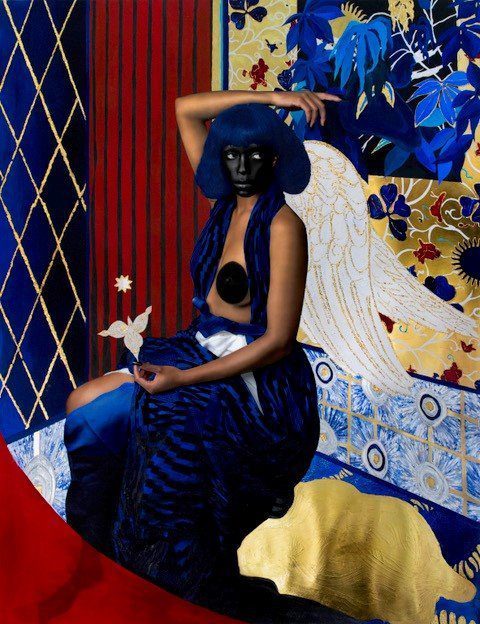
“Second” was the second of eleven large-scale paintings shown at the New Orleans Museum of Art last year, where one reviewer compared her Sibyll to the Babylonian Lillith, an ancient demon and sensual goddess – I guess every mythology has to have one.
Viktor’s Sibyll is shown holding a white flower with three petals. Don’t ask Charles Day, if you remember he’s Wave Hill’s Senior Horticultural Interpreter, to speak for the flower. I wracked my brain … orchid, lily. No, it’s a reference to Chris Ofili’s “Within Reach” series, which shows several three-petal (or leafed) bouquets and represents “paradise, freedom and unity.”
Sometimes you just have to read the gallery card, people. Yes, she signature gold/gold leaf is there, and so is the wonderful cobalt blue.
At last, a chance to go outdoors. The other artwork that interacts directly with Wave Hill’s environment is Cecile Chong’s installation “El Dorado – The New Forty-Niners.”
You can see the whole thing above, but I want to show you a close up of the “guaguas.” I had to look them up so you don’t have to. Guagua, in Chile, Ecuador, Perú, Bolivia and Argentina, means little baby, or tyke, toddler. Cecile Chong was born in Ecuador, and now works in Brooklyn. So here are the guaguas behind Glyndor House. Signs will direct you to the glade.
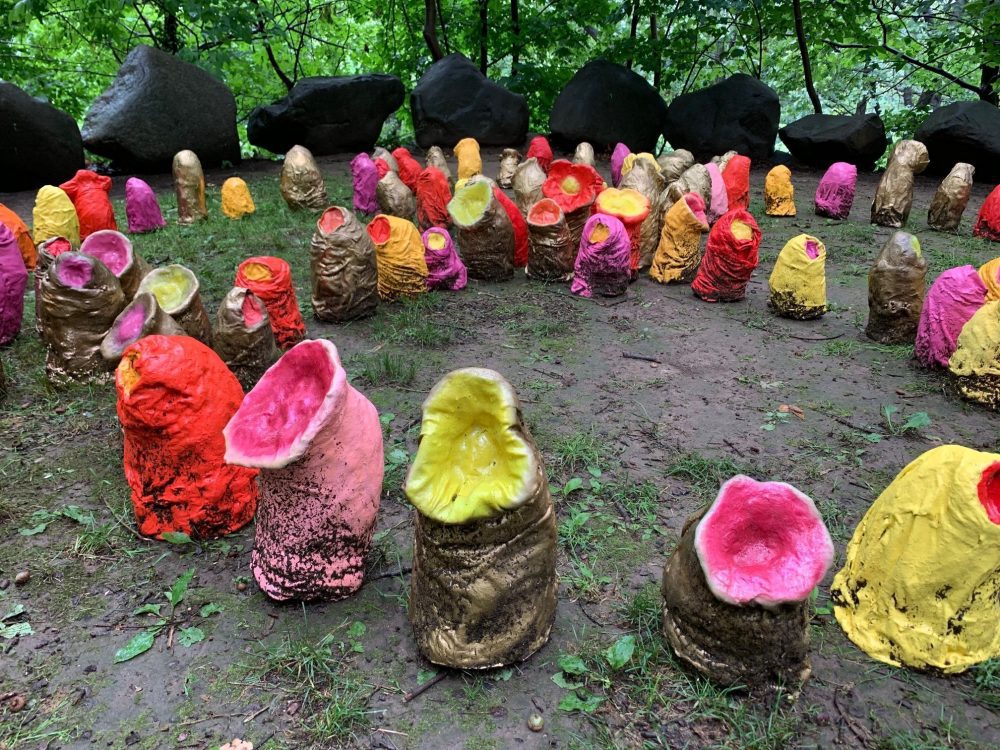
An explanation of the title. It pays tribute to the idea of immigration, and represents the 49 percent of New Yorkers who speak a language other than English at least some of the time at home. It is a traveling exhibit to appear in all five boroughs, and has already appeared in Queens and Brooklyn.
Here 100 guaguas were arranged in the shape of a flower inside an existing stone circle. It is up to you to count how many are painted gold, and how many of those have failed to open into full flowered shapes. Then you can figure out which ones represent the 49 percent.
